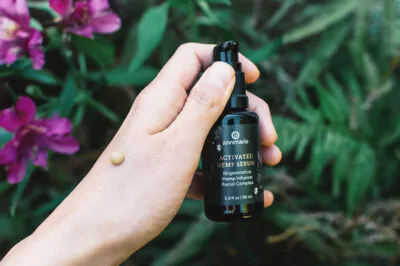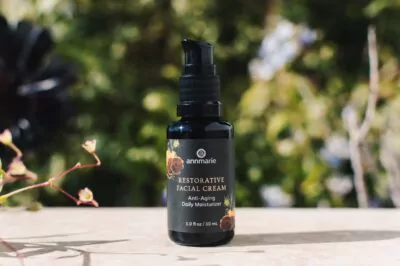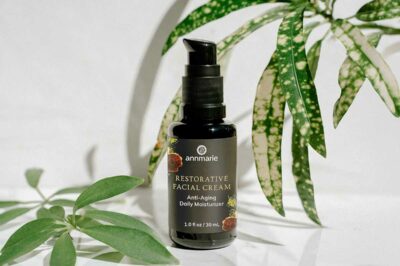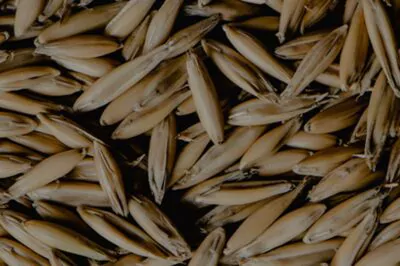Sunscreens. Used to be you could just slap one on and go out feeling protected and at ease.
Not so much anymore. Studies have shown that a number of chemicals in sunscreens, such as PABA, cinnamates, oxybenzone, and more can react with the sun’s rays to create damaging free radicals, which may actually increase the risk of skin cancer.
Chemical sunscreens have also been linked with hormone disruption. Research has found that they can act like estrogen in the body, throwing natural hormones off balance. In a study of six common sunscreen chemicals, five acted like estrogen, causing an increase in human breast cancer cells.
Another concern with these sunscreens is that they have the potential to penetrate deeply into skin, getting inside the body. A 1999 study, for instance, found that all sunscreen agents tested penetrated into the skin, with benzophenone-3 (oxybenzone) passing through in significant amounts. In 2008, the Centers for Disease Control and Prevention (CDC) reported that nearly all Americans were contaminated with oxybenzone, which has been linked with hormone disruption and allergies.
To get away from these risks, most dermatologists and other skin care experts recommend using so-called “physical” sunscreens like titanium dioxide and zinc oxide.
Here’s more on the subject, and why we chose zinc oxide for our formula to protect skin from cancer and premature aging.
Chemical Sunscreens vs. Physical Sunscreens
For many years now, people have been categorizing sunscreens into two groups—physical and chemical. Chemical sunscreens are made in the laboratory and are like those listed above—cinnamates, oxybenzone, etc. They are said to reduce sun damage by absorbing UV rays and robbing them of their harmful power.
Physical sunscreens, on the other hand—like zinc oxide and titanium dioxide—are made of natural elements found on the earth, and are said to “block” or “scatter” UV rays so they never penetrate the skin in the first place. Later research showed this wasn’t entirely true—physical sunscreens absorb UV rays as well—but they do retain some scattering ability, depending on the size of the UV wavelength. It all gets very scientific, but you can still think of these two groups when thinking about the different types of sunscreens available.
In general, physical sunscreens are considered to be the safer options because they offer a more broad-spectrum protection and lack the hormone-disrupting effects.
What is SPF?
Most sunscreens list an SPF number on the label. SPF stands for “sun protection factor,” and is a measurement of protection from only UVB rays, which are the ones that cause redness and sunburn.
UVA rays are considered even more dangerous, as they penetrate skin more deeply and are linked to skin cancer. But SPF does not measure a sunscreen’s protection against UVA rays—only UVB rays.
To further explain—the SPF is a measurement of the difference between the amount of sunlight that causes redness in sunscreen-protected skin and the amount that causes redness in unprotected skin. A sunscreen with an SPF of 15 theoretically gives you 15 times the minutes to stay out before you burn.
Example: if you usually burn in 10 minutes, and you apply an SPF 15 product, you can stay out for 150 minutes.
There are some problems with this equation, though. It makes people believe that an SPF of 30 would allow them to remain twice as long in the sun as an SPF 15. In truth, an SPF 15 blocks about 93 percent of UVB rays, while an SPF 30 blocks about 97 percent, and an SPF 50 about 98 percent. So going higher and higher doesn’t necessarily create more protection after a certain point.
In addition, these numbers have nothing to do with UVA rays, so people who slather on an SPF of 50 and stay in the sun for hours are likely to suffer even more severe skin damage if they don’t have a “broad spectrum” sunscreen that protects from both UVA and UVB rays.
In addition, high SPF products are often made with greater percentages of chemical ingredients, which may be linked to hormone disruption, trigger allergic reactions, and potentially expose you to more free-radical damage.
The Benefits of Zinc Oxide
When formulating our natural sun protection, our highest priorities were broad-spectrum protection and safety. We wanted to offer our customers protection from both UVA and UVB rays, which cause premature aging.
Zinc oxide has had a long history of use as a sun protection. It offers broad-spectrum protection, shielding you from both UVB rays, which cause sunburn, and UVA rays, which penetrate more deeply and may be more dangerous.
Zinc is an essential mineral that we actually need in our bodies for optimal function, and is the only active sunscreen ingredient approved by the FDA for infants under six months.
Bottom Line
There’s no doubt that UV exposure increases the risk for skin cancer and accelerates the effects of aging. A healthy skin-care regimen must include protection. We’ve combined the best of all worlds by including the following in our formula:
- Zinc oxide, which is still considered the safest option in sunscreens. It’s the only sunscreen recommended by the FDA for babies. It offers superior broad-spectrum protection against both UVA and UVB rays.
- Antioxidants, which help the skin with environmental stressors. That’s why we pack our products full of them! If you’re regularly using our skin care products, or apply other forms of antioxidants to your skin, you’re getting an added boost of protection. We added antioxidant-rich buriti fruit and sunflower seed oil to the new formula.
- Naturally soothing ingredients help reduce skin’s reaction to the sun, allowing it to glow with radiance. We’ve included ingredients like lavender and hemp seed oil that can naturally make your skin feel calm and cool.
- Natural moisturizers which keep skin soft and healthy. The stronger your skin is, the better it is able to resist harmful stressors. Moisture is a key part of this process, as dry skin is likely to crack and flake, making skin more vulnerable to premature aging. Our Sun Love formula is an oil-based product that both protects from the sun’s rays and deeply moisturizes.
We’re excited about our new Sun Love – Natural Sun Protection. Have you tried it? What do you think?








Would live to try this product,where can I buy it please?
Hi Kay!
You can buy Sun Love here – https://shop.annmariegianni.com/products/sun-love-natural-sunscreen
What about applying Sun Love to the lips as well for sun protection? Also, it would be so very nice if you could/would formulate a chemical-free lipstick to add to your line of products!! Thanks!
Hi J! You can try applying Sun Love to your lips, but since it’s tinted, it might not give you the lip color you want. Hopefully you’ll a lip product from us soon. 🙂
There’s some serious research and thinking you’ve done to produce this product. I appreciate that you’re using zinc oxide, though you haven’t stated the percentage of it in relationship to the whole product amount, nor the percentage needed for effectiveness over a given time period.
AND, your info about titanium dioxide means I’ll be returning my brand new children’s SPF 50 sunscreen for babes . . . I’m the ‘baby’ here and likely purchasing yours! For the lady above mentioning not using the sunscreen on overcast days I just want to say: “Beware!” Sunburns can easily occur on overcast days, so once you start a sunscreen regimen you will want to do it all the time!
Hi Lynne-
The Zinc Oxide makes up 18% of the entire formula. We recommend reapplying the Sun Love every hour (if actively in the sun) or every couple of hours throughout the day if you are moderately in the sun.
Hope this info helps!
Your sunscreen is the absolute best. From the texture, smell and color to the fact that there are no harsh and dangerous chemicals makes me smile. It’s nice to know I’m putting something on my face that does what it says and it safe and effective. I was excited to review it because I fell in love with it. Also a little goes a long way so the sample size is great for travel-thank you.
Thanks Karina!
We love it too 🙂
Really great article explaining the nuts and bolts of sunscreens – well done on your new product!
I love this article and look forward to trying your product! I saw a Dermatologist a month ago and as skin cancer is in my family history, he gave me a serious talking to about my excessive exposure to the sun in my lifetime. (I am originally from Australia, therefore life in the sun is part of life! I live in Canada now where sun exposure doesn’t happen daily!). However he insisted I must wear 100 SPF sunscreen & gave me a recommended list of brands. All containing lots of chemicals that you have listed in your article. This article has cleared up a lot of my concerns for the harmful ingredients in sunscreens. Thank you again for such a great article!
Thanks Hayley!
We wanted to clarify a lot of the sunscreen jargon out there. Let us know if you have any questions about the product at info@annmariegianni.com 🙂
I zinc oxide is good to use as sunscreen. Is your product greasy or dry up quickly?
Hi Theresa!
I believe that our Sun Love Sun Protection goes on incredibly smooth and light. No greasy residue, but rather a glow! There are some moisturizing and sun protecting oils in the cream as well which makes it a very nourishing formula for the skin.
Can’t wait to try it and to have such a high quality product to recommend to others! Thank you!
I haven’t gotten to try sun love out in as a sunscreen yet, too overcast yet! But I like the sample I received as a moisturizer . My only question is, since it has a slight tint to it (which makes it a great make up alternative!) will there be an untainted version for body?
Goodness! All thumbs today! I like using it as a moisturizer, and of course I meant un-tinted, not untainted! Silly autocorrect. Let’s try that again:
I haven’t had a chance to try it out in the full sun yet, too overcast still. But I am using my sun love sample as a moisturizer and alternative to make up (since it is tinted). I was wondering, will there be an un-tinted version for use on the body?
Hi Dawn!
We definitely recommend using the Sun Love everyday, even when it’s overcast. You are still being exposed to UV radiation. The sun is very powerful, so make a habit of wearing it daily for ultimate protection 🙂 At this time, we are not coming out with a untinted body sun protection. We added Iron Oxides to the formula to balance out the white that comes from Zinc Oxide. Feel free to use on your neck line, too – just beware of white clothing as it may stain!
Do you use micronized zinc oxide? What are the size of your particles?
Just curious if your zinc is non-nano. Thanks!
Yes, our zinc is Non-Nano.
Is this Ok for most body parts that may be exposed, such as torso, legs/arms, face/ears, and lips too?
Thanks!
Hi BB-
We recommend using proper sun protection for all areas of the body.
Our Sun Protection lotion is generally used for the face/neck/decollete. It may also be used on other parts, though the size of our bottle is only 2.5 oz and the formula is also tinted so it could stain clothing. Always wear a hat/sunglasses and try and cover up as much as possible on the body when out in the sun!
WOW…Revolutionary. Sounds fanastic! Can’t wait to try. I am fair skinned and need something naturel instead of all the chemicals. Thanks!
Gluten free and egg free? Not too thick cream or lotion. Had tried several organic kind but theses dried out too quickly in a tube. Hope your kind is better for me to try.
What about using non-nano coated zinc oxide? Badger sunscreen uses it in their products, what do you think about it?
I am interested in trying your sunscreen. I have very sensitive skin and swim in the outdoors. Thur the years I have tried many sunscreen with the least amount of chemicals, and tried to make my own. It will be great to find a sunscreen that protects & is very pure.
I work with essential oils and can appreciate the contents & purity of your products.
Thank you.
I have been waiting for you to come out with a sunscreen! I really love your newest product Sun Love. It smells really nice, goes on smoothly and feels light. It is not greasy feeling and leaves your skin feeling great. Now I can’t wait to get a bigger bottle!
Thanks for putting your efforts into such a great new product 🙂
Thanks for the kind feedback, Lisa!
Thanks so much for this great article! I have been confused about this topic for so long! I have used many different sunscreen tactics–from using nothing so as to avoid the chemicals, to vitamin supplement astaxthanin for myself and my kids, and now a daily organic tomato suncream with SPF 16. And now I have pigmentation spots!!! Do you have any natural tips for reducing these spots? My husband is a pilot and is in the skies all the time so he is concerned for his skin too! I love your products and can’t wait to get my hands on Sun Love!
Hi Nadine!
For sun spots, we recommend using our Citrus Stem Cell Serum which is an active Vitamin C serum. Vitamin C is a natural and safe pigment reducer and a very potent antioxidant. This serum will help to regenerate the skin and also help repair existing sun damage and fade discolorations.
Ism very excited about your sunscreen. I hate putting chemical sunscreens on my children. You are a trusted name in our household and I feel very safe using your products I my family!
I love your products and am very excited about the introduction of safe sunscreen. As a new grandmother I hate the idea of putting chemicals on these sweet babies. I would love to try a sample of your product.
Very nice article! i only am wondering when you put this on example on your face how long you can stay on average with sunburn in the sun depending on skintypes.
SPF gives a good calculation what the average protection is but what is dat for the amazing zinc ?
In you article as well on your website it isnt clear and i see more people have the same question.
looking forward to your reply
thanks
Very enlightening, thank you.
Love this blog! Very informative. Could you please address nano particles & where your new product fits in with that discussion? Is nano the same as “microfine” mentioned at the links in the blog? Thank you for making this product & for all you do!
I love my sample of this product. I’ve always hated the feeling of sunscreen on my skin and even more, the thought of all those chemicals on my body…and being washed off in a pool or ocean or in the shower. I knew it couldn’t be good for anyone but what to do? I am happy to know that now there is an alternative! I just hope it’s affordable 🙂